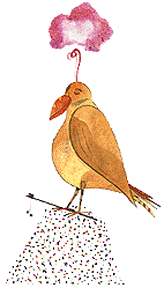The Brown Moo Bird
 At first glance The Brown Moo Bird may seem to be merely another colorful children's book. And, of course, it is -- preeminently and outstandingly -- an exquisite example of this beguiling genre. But, to the discriminating adult, it is much more than that. Like Lewis Carroll's immortal classic, with which it has much in common ontologically, the Moo Bird has a subtext that, to the more inquiring and flexible mind, brings to life in an engaging manner a profound understanding of a separate reality, a world that remains forever occult in us, in the mysterious subconscious of dreams, magic, and psychedelic forces. It is submerged in an unexplored hinterland of the psyche.
At first glance The Brown Moo Bird may seem to be merely another colorful children's book. And, of course, it is -- preeminently and outstandingly -- an exquisite example of this beguiling genre. But, to the discriminating adult, it is much more than that. Like Lewis Carroll's immortal classic, with which it has much in common ontologically, the Moo Bird has a subtext that, to the more inquiring and flexible mind, brings to life in an engaging manner a profound understanding of a separate reality, a world that remains forever occult in us, in the mysterious subconscious of dreams, magic, and psychedelic forces. It is submerged in an unexplored hinterland of the psyche.
This world of inner space, beyond reason, logic, and gravity, beyond the assumptions of perceived reality, is first glimpsed in early childhood and then, through rigorous social conditioning, is lost to us forever. In a way, all adults reach for it at one time or another, trying to find again what they once thought they saw, a paradise, an Eden, a place of the soul, the spirit, a place of innocence and beauty, where plants, beasts, and objects talk.
The search goes on until, that is, certain unusual books come along like Huxley's Doors of Perception or Castaneda's Don Juan books, or as in this case, a seemingly simple children's book. And then, lo! we recognize a buried treasure, a hidden world in ourselves. We return to Wonderland.
Aymon de Roussy de Sales has taken us on a journey to this world where time and the mundane physical world stop, and another world begins. With such books the standard version of reality, with its constantly shifting boundaries through new perceptions in astrophysics, keeps changing, telling us that we hold mostly false assumptions about our physical world, our planet, our universe, and about spacetime, cause and effect, and indeed about how we see others and ourselves.
It is this psychedelic shift from the standard version of reality -- first achieved a century ago by Lewis Carroll -- that gives Moo Bird its individual distinction. This authentic new window on the wonderland within each of us opens a sphere beyond the one we have been taught to see, hear, touch, smell, taste, and believe in as the only real world. Moo Bird authenticates, through its unique visual images of psychotropic plants and animals, a delicious surreality that we can enjoy with complete safety and sanity and fresh, innocent eyes, without having to commit ourselves to shrinks, drugs, or doctors afterwards. It is perfectly sane, in the original meaning of "healthy." Moo Bird takes us on a trip and gives us a rare treat in this unusual and subtle exploration of inner space.